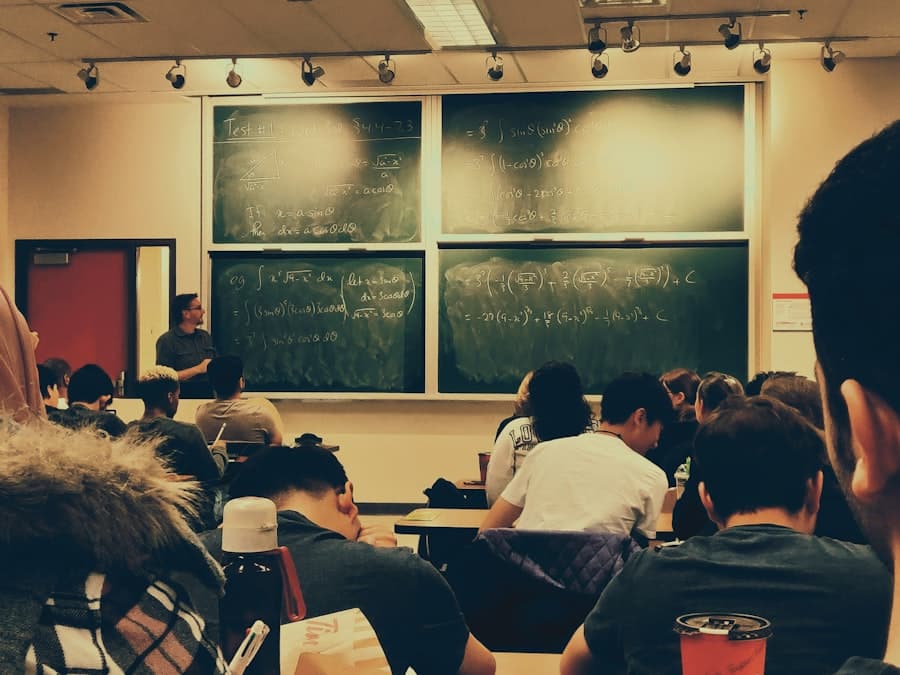Augmented Reality (AR) has emerged as a transformative technology in various fields, and its application in education, particularly in mathematics, is gaining traction. By overlaying digital information onto the physical world, AR creates immersive learning experiences that can significantly enhance students’ understanding of complex mathematical concepts. This innovative approach allows learners to visualize abstract ideas, making them more tangible and accessible.
As educators seek to engage students in a subject often perceived as challenging, AR offers a promising avenue to bridge the gap between theoretical knowledge and practical application. The integration of AR into math education is not merely a trend; it represents a paradigm shift in how mathematical concepts are taught and understood. Traditional methods often rely heavily on rote memorization and abstract reasoning, which can alienate students who struggle to see the relevance of math in their everyday lives.
AR addresses this issue by providing interactive experiences that connect mathematical principles to real-world scenarios. For instance, students can manipulate 3D geometric shapes or visualize algebraic equations in real time, fostering a deeper comprehension of the material. As educators increasingly recognize the potential of AR, it is essential to explore its benefits, challenges, and future implications for math education.
Key Takeaways
- AR in math education enhances student learning by providing interactive and immersive experiences.
- Real-time problem solving in math education allows students to apply concepts in practical scenarios, improving their understanding.
- AR enhances student engagement and motivation in math by making learning more interactive and enjoyable.
- AR provides instant feedback and support for students, helping them to identify and correct mistakes in real time.
- AR facilitates collaborative learning and peer-to-peer problem solving, allowing students to work together to solve math problems.
The Benefits of Real-Time Problem Solving in Math Education
One of the most significant advantages of incorporating AR into math education is the ability to facilitate real-time problem solving. Traditional classroom settings often limit students to static problems presented on paper or screens, which can hinder their ability to engage with the material dynamically. In contrast, AR allows students to interact with mathematical problems in a more fluid and responsive manner.
For example, when working on geometry, students can manipulate virtual shapes directly in their environment, adjusting angles and dimensions while observing the immediate effects of their changes. This hands-on approach not only enhances understanding but also encourages experimentation and exploration. Moreover, real-time problem solving through AR can cater to diverse learning styles.
Visual learners benefit from seeing concepts represented in three dimensions, while kinesthetic learners engage more effectively when they can physically manipulate objects. This adaptability makes AR an inclusive tool that can address the varying needs of students within a single classroom. Additionally, the immediacy of feedback provided by AR applications allows students to identify mistakes and misconceptions as they occur, promoting a growth mindset and encouraging resilience in problem-solving.
By fostering an environment where students can learn from their errors in real time, AR cultivates a more profound understanding of mathematical concepts.
How AR Enhances Student Engagement and Motivation in Math

Engagement is a critical factor in effective learning, particularly in subjects like mathematics that can often feel abstract or disconnected from students’ lives. AR has the potential to transform the learning experience by making math more interactive and enjoyable. When students are immersed in an augmented environment where they can visualize and manipulate mathematical concepts, their motivation to learn increases significantly.
For instance, an AR application that allows students to explore fractals or patterns in nature can spark curiosity and inspire them to delve deeper into mathematical theories. Furthermore, the gamification aspect of many AR applications adds an element of fun to learning math. By incorporating game-like features such as challenges, rewards, and progress tracking, AR can motivate students to engage with the material actively.
This approach not only makes learning more enjoyable but also encourages healthy competition among peers.
The combination of interactivity and gamification creates an environment where students are more likely to take ownership of their learning journey.
The Role of AR in Providing Instant Feedback and Support for Students
In traditional educational settings, feedback is often delayed, with students waiting for assignments to be graded before receiving insights into their performance. This lag can hinder learning, as students may not fully understand their mistakes until much later. AR technology addresses this issue by providing instant feedback during the learning process.
For example, when a student uses an AR app to solve a math problem, they can receive immediate notifications about incorrect answers or suggestions for alternative approaches. This real-time feedback loop allows students to adjust their thinking on the spot, reinforcing their understanding of mathematical concepts. Additionally, AR can offer personalized support tailored to individual student needs.
Many AR applications are designed with adaptive learning algorithms that assess a student’s performance and adjust the difficulty level accordingly. If a student struggles with a particular concept, the app can provide additional resources or alternative explanations to help them grasp the material better. This level of personalized support is particularly beneficial in math education, where students often have varying degrees of proficiency and confidence.
By ensuring that each student receives the guidance they need when they need it, AR fosters a more supportive learning environment.
How AR Facilitates Collaborative Learning and Peer-to-Peer Problem Solving
Collaboration is an essential component of effective learning, particularly in subjects like mathematics that often require teamwork and communication skills. AR technology enhances collaborative learning by enabling students to work together in shared augmented environments. For instance, multiple students can interact with the same virtual object simultaneously, allowing them to discuss strategies and approaches while solving problems collectively.
This collaborative aspect not only promotes teamwork but also encourages peer-to-peer learning, where students can share insights and techniques with one another. Moreover, AR can facilitate remote collaboration among students who may not be physically present in the same location. With the rise of online learning environments, AR applications can connect learners from different geographical areas, allowing them to engage in joint problem-solving activities regardless of distance.
This capability broadens the scope of collaborative learning beyond traditional classroom boundaries and prepares students for a globalized world where teamwork often transcends physical spaces. By fostering collaboration through AR, educators can cultivate essential skills such as communication, critical thinking, and adaptability.
Overcoming Challenges and Barriers to Implementing AR in Math Education

Despite its numerous benefits, the implementation of AR in math education is not without challenges. One significant barrier is the accessibility of technology. While smartphones and tablets are increasingly common among students, not all educational institutions have the resources necessary to provide AR-compatible devices or software.
This disparity can create inequities in learning opportunities, particularly for underprivileged schools or communities. Addressing this issue requires strategic planning and investment from educational stakeholders to ensure that all students have access to the tools they need for effective learning. Another challenge lies in teacher training and professional development.
Educators must be equipped with the knowledge and skills necessary to integrate AR into their teaching practices effectively. Many teachers may feel overwhelmed by new technologies or lack confidence in their ability to implement them successfully in the classroom. To overcome this barrier, comprehensive training programs should be developed that focus on both the technical aspects of using AR tools and pedagogical strategies for incorporating them into math instruction.
By empowering teachers with the right resources and support, schools can create an environment conducive to successful AR integration.
Case Studies and Examples of Successful AR Integration in Math Education
Several educational institutions have successfully integrated AR into their math curricula, demonstrating its potential impact on student learning outcomes. One notable example is the use of AR applications in middle school geometry classes at a school in California. Teachers implemented an AR program that allowed students to visualize geometric transformations by manipulating virtual shapes on their tablets.
The results were remarkable; students reported increased engagement and improved understanding of complex concepts such as congruence and similarity. Assessments showed a significant increase in test scores compared to previous years when traditional teaching methods were employed. Another compelling case study comes from a high school in New York that adopted an AR-based algebra curriculum.
Students used an app that enabled them to visualize algebraic equations as interactive graphs projected onto their desks. This hands-on approach allowed learners to explore relationships between variables dynamically and provided instant feedback on their problem-solving attempts. Teachers noted that students who previously struggled with algebra demonstrated newfound confidence and enthusiasm for the subject matter.
These examples illustrate how effective AR integration can lead to enhanced student engagement and improved academic performance.
The Future of AR in Math Education: Potential Developments and Opportunities
As technology continues to evolve, the future of AR in math education holds exciting possibilities for further enhancing teaching and learning experiences. One potential development is the integration of artificial intelligence (AI) with AR applications, allowing for even more personalized learning experiences. AI algorithms could analyze student performance data in real time and adapt AR content accordingly, providing tailored challenges that align with each learner’s unique needs and abilities.
Additionally, advancements in hardware technology may lead to more immersive experiences through wearable devices such as smart glasses or headsets specifically designed for educational purposes.
Furthermore, as educators continue to explore innovative ways to integrate AR into their curricula, collaborative partnerships between tech companies and educational institutions may emerge.
Such collaborations could lead to the development of specialized AR tools designed explicitly for math education, ensuring that content aligns with curriculum standards while maximizing engagement. In conclusion, the future of augmented reality in math education is bright with potential developments that promise to revolutionize how mathematics is taught and learned across various educational settings.
A related article to “How AR Enables Real-Time Problem Solving in Math Education” is “Top 10 Best Laptops for SolidWorks in 2023: Expert Guide with Lenovo, Dell Workstations.” This article discusses the importance of having the right technology tools, such as laptops, for students and professionals working in design and engineering fields. With the advancement of technology, having a powerful laptop that can handle complex software like SolidWorks is crucial for success in these industries. To read more about the best laptops for SolidWorks, check out the article here.
FAQs
What is AR?
AR stands for Augmented Reality, which is a technology that superimposes digital information such as images, videos, or 3D models onto the real world environment.
How does AR enable real-time problem solving in math education?
AR enables real-time problem solving in math education by providing interactive and immersive experiences for students. It allows students to visualize and manipulate mathematical concepts in a 3D space, making abstract concepts more tangible and easier to understand.
What are some examples of AR applications in math education?
Some examples of AR applications in math education include interactive geometry tools, virtual manipulatives for arithmetic operations, and immersive simulations for understanding complex mathematical concepts such as calculus and trigonometry.
What are the benefits of using AR in math education?
The benefits of using AR in math education include increased student engagement, improved understanding of abstract mathematical concepts, and the ability to provide personalized and adaptive learning experiences for students.
Are there any challenges or limitations to using AR in math education?
Some challenges and limitations of using AR in math education include the cost of implementing AR technology in classrooms, the need for training teachers to effectively integrate AR into their teaching practices, and the potential for distraction if not used appropriately.

